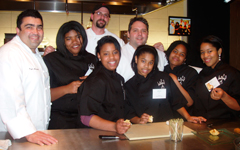Getting Into the Holiday Spirit
The holiday season is here. And, boy, have we been celebrating here at Brainfood! We kicked it all off with our delicious Thanksgiving menu comprised of smoky macaroni and cheese, green bean casserole, spinach artichoke dip, stuffing, pumpkin pie and an apple crumble.
And as we moved into December, it was time for even more holiday foods. In an effort to be as inclusive as possible, we made potato latkes (a staple of Chanukah and the Jewish tradition), Hoppin’ John (a traditional Southern New Year’s Eve food), and a Bouche de Noel (a classic French dessert for Christmas time). These dishes all represented a taste of different religions and cultures.
As a member of an interfaith family; inclusivity has been paramount in how I navigate the holiday season and the world in general. Though raised Jewish, as the daughter of a Catholic and a Jew, I was always encouraged to explore many other religions and cultures. To see those same values of inclusion and exploration incorporated into the Brainfood curriculum is wonderful for me.
Thanks to my intrinsic curiosity, I find that one of the most invigorating parts of my job at Brainfood is the non-stop learning that takes place every day. When deciding on our Holiday Foods menu, Nina, my officemate in crime and fellow holiday food enthusiast, suggested the Buche de Noel. It was a dish that been a longstanding part of her family Christmas menu, and she was eager to share the recipe with Brainfood students. Despite having no clue what it was, I felt really excited by her description of this rolled cake. Her memory of the delicious taste and also of the fun she had intricately decorating the yule log made me certain this dish had to be on the menu.
"The history of the Yule log cakes stretches all the way back to Europe’s Iron Age, before the medieval era. Back then, Celtic Brits and Gaelic Europeans would gather to welcome the winter solstice at December’s end. People would feast to celebrate the days finally becoming longer, signaling the end of the winter season. To cleanse the air of the previous year’s events and to usher in the spring, families would burn logs decorated with holly, pinecones or ivy. Wine and salt were also often used to anoint the logs. Once burned, the log’s ashes were valuable treasures said to have medicinal benefits and to guard against evil. Some groups claimed it would protect the bearer from lightning—an important quality at a time when houses (and most of the contents in them) were made of wood. “The Yule log cake (or Buche de Noel for French speakers) is an elaborate creation consisting of a rolled, filled sponge cake, frosted with chocolate buttercream to look like tree bark and festooned with meringue mushrooms, marzipan holly sprigs, spun sugar cobwebs and any other sort of edible decoration."
It was so much fun to share this story and Nina’s memories with my students. And it's even more fun to know that my exploration of different religions, cultures and foods will continue to be part of my job at Brainfood. Here's to a holiday season filled with cross-cultural learning, researching the origins of traditional foods, and of course, lots of cake!







Comments
Post new comment